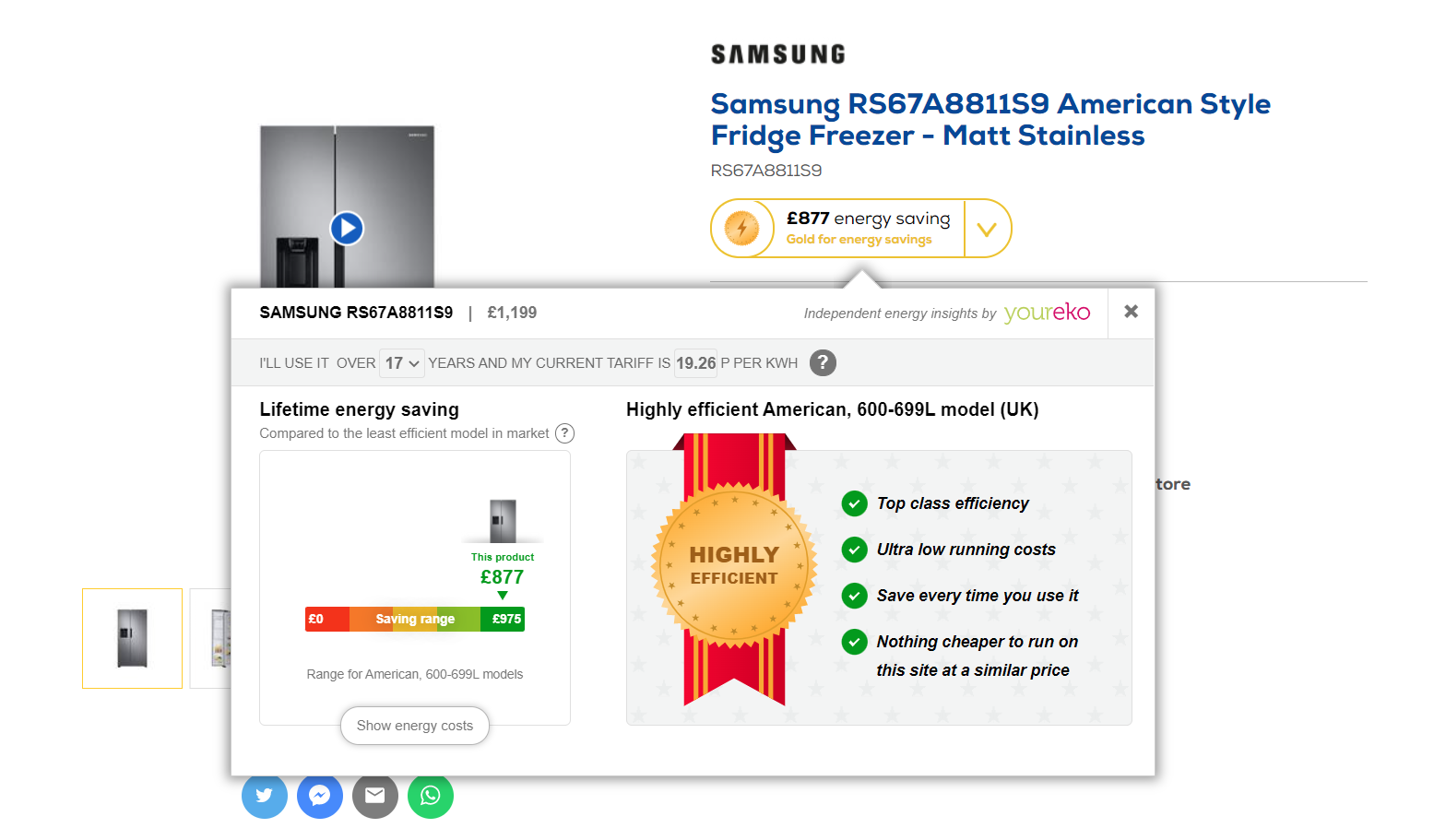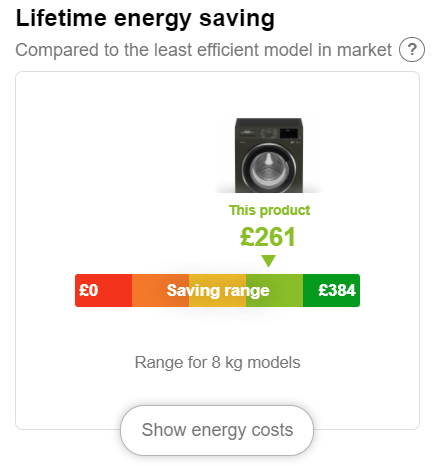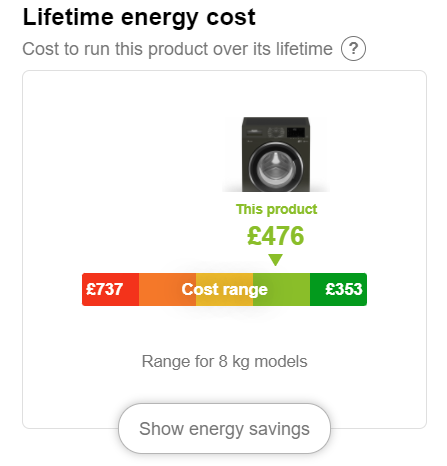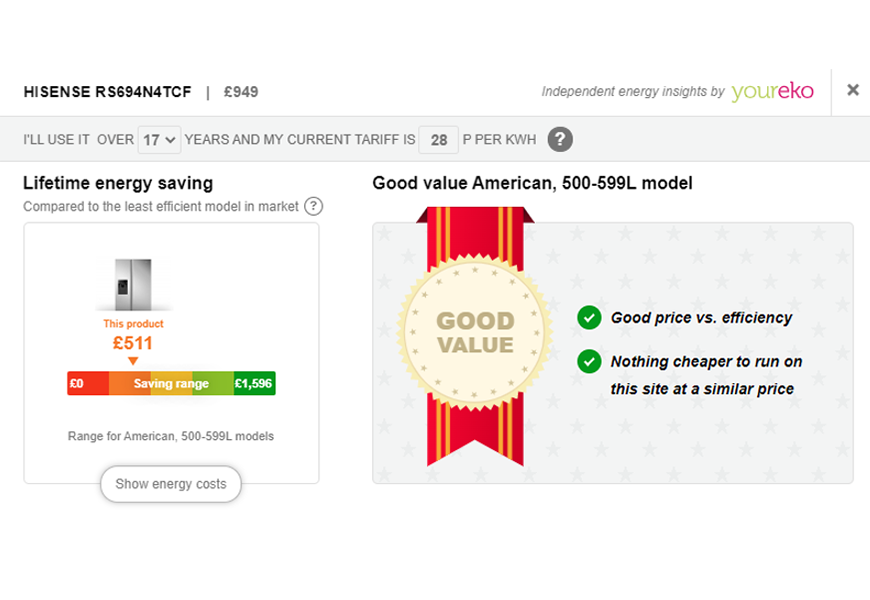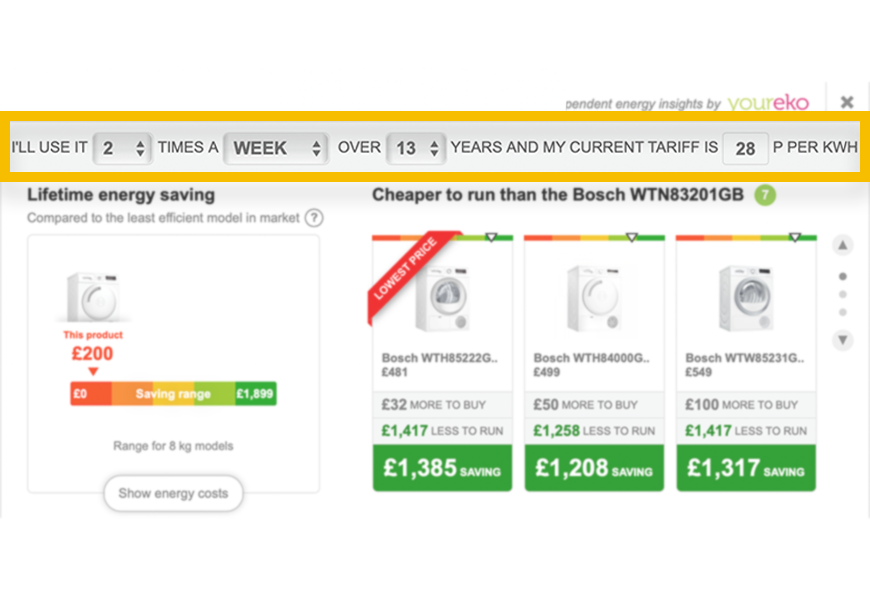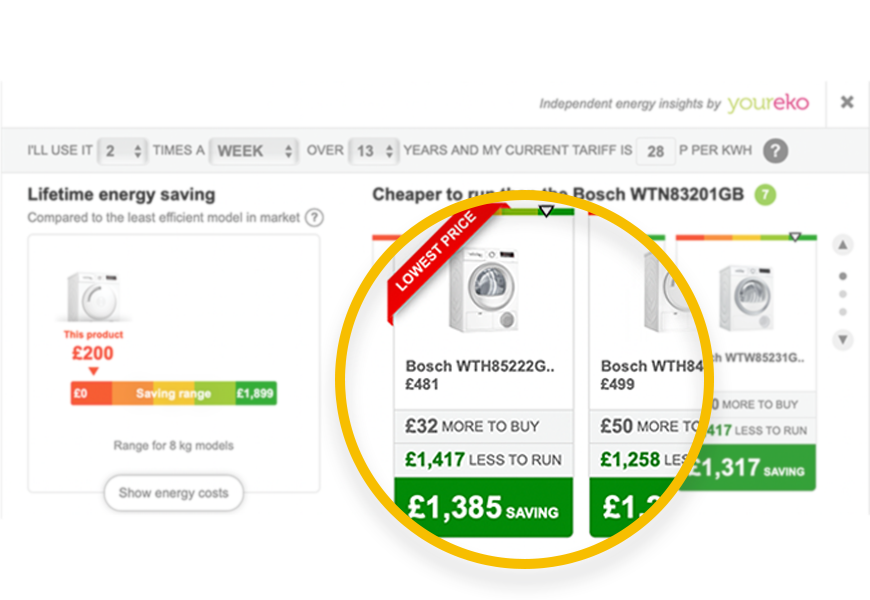Energy Savings Explained
Youreko’s Energy Savings Tool helps you understand the financial benefit of buying an energy efficient appliance. Making sustainable choices is great for the environment, and help save you money. You’ll find the tool on laundry, dishwasher, and refrigeration products.
Try Youreko today to see how much you could save.
You'll also see more information about energy efficiency labels on the appliances you purchase. To find out what it all means, visit our dedicated energy label page.
How It Works
1. Products in the market are loaded from the manufacturer and/or retailer sites.2. The lifetime energy cost is calculated across all products.
3. The tool then provides unique data by comparing the energy cost of like-for-like products.
Medal Ratings Explained
We place products by size into five bands according to their energy savings. A medal rating is then given to each product based on the band it is in.
Good Value
Highest 40% of running costs but nothing cheaper to run at that price
Bronze
Lowest 60% to 40% of running costs (yellow range)
Silver
Lowest 40% to 20% of running costs (light green range)
Gold
Lowest 20% of running costs (dark green range)
Best of the Best
Most efficient product in the market with the lowest running cost in its category.
Medal Rating
Products are given a gold, silver, or bronze medal rating based on their energy savings.
For example, the tool displays "Gold for energy savings" when you view an 8kg tumble dryer, which has been compared to all 8kg tumble dryers available. The best rated 8kg tumble dryers for energy savings will be displayed.
Customise to your usage
Use the tool to customise your usage for different appliances to show you energy savings based on your personal circumstances.
Recommendations
Youreko's tool makes recommendations for each product based on any alternatives that provide a clear financial benefit in energy savings.
For example, if you're looking for a 9kg washing machine, the tool may find an alternative product which costs an extra £30 to buy but you'll spend £149 less running it, saving you £119.
Searching for appliances like this means you'll find similar products which may be more expensive to buy but will save you money in the long term.
FAQs
+ How often are products loaded from the market?
Products are loaded from the market daily. New products are usually added to the database in 1-2 days.
+ How is the lifetime energy cost calculated?
Information from official sources is used to calculate the initial average lifetime energy cost of a product shown.
Power consumption. This is taken directly from the product fiche published by the manufacturer.
Average usage. The average usage for different categories is taken from a report by the Energy Saving Trust.
Average lifespan. The average lifespan for each category is taken from a report by the Energy Saving Trust.
Average tariff. This is taken from data published by BEIS.
Average annual tariff increase. This is aken from BEIS. Historic data for tariffs over the last 10+ years is reviewed to determine the average annual increase in electricity costs.
To see the actual values, you can click on the help icon (?) in the tool.
Here is an example calculation of the operating cost in year one for a washing machine:
| Description | Value |
| (A) Power consumption | 0.55 kWh per cycle |
| (B) Usage | 284 cycles per year |
| (C) Tariff | 34p per kWh |
| (D) Yearly power consumption | 156 kWh |
| (E) Cost per cycle | 18.70p |
| Electricity cost calculation | (A* B* C*) / 100 = £53.11 |
The annual increase in electricity costs over 11 years is then applied, which results in a lifetime energy cost of £584.21.
+ What are like-for-like products?
All of the savings, ratings and comparisons are based on like-for-like products, which in general terms is the size or capacity of a product. Examples of classifications:
Dishwashers. Classified by size: compact, slimline, or full size.
Freezers. Classified by type and capacity:
• Chest - 100 - 199 litres
• Chest - 200 - 299 litres
• Undercounter
• Upright - 100 - 199 litres
• Upright - 200 - 299 litres etc.
Fridge freezers. Classified by type and capacity:
• 50/50 - 100 - 199 litres
• 50/50 - 200 - 299 litres
• American/Side by Side - 500 - 599 litres
• American/Side by Side - 600 - 699 litres, etc.
Fridges. Classified by type and capacity:
• Larder undercounter
• Larder - 100 - 199 litres
• Larder - 200 - 299 litres
• Ice box undercounter
• Icebox - 100 - 199 litres
• Icebox - 200 - 299 litres, etc.
Tumble dryers. Classified by capacity: 7 kg, 8 kg, 9 kg, 10 kg, etc.
Washer dryers. Classified by wash capacity: 7 kg, 8 kg, 9 kg, 10 kg, etc.
Washing machines. Classified by capacity: 7 kg, 8 kg, 9 kg, 10 kg, etc.
It’s essential to compare like-for-like as, it would not make sense to compare the running costs of a 6 kg washer with a 10 kg washer, as the larger capacity washer is likely to use more energy.
For refrigeration, as there are no standard sizes, products are sub-categorised by type and capacity for comparison. For example, it wouldn’t be beneficial to compare a larder fridge with a model that has an ice-box, because freezers use much more energy. Similarly, you wouldn’t compare a 50/50 split freezer with a 70/30 split model, as the 50% freezer will use a lot more energy than the one with 30% freezer.
+ Why is the least efficient product used for comparison?
We use the least efficient product for two reasons. Firstly, the cheapest products are generally the least efficient and as many of us tend to buy cheap to save money, this represents a good benchmark for comparison.
Secondly, one of the best ways to understand how energy efficient a product is compared to others, is to see where it sits in the range for all products in the market. By comparing with the least efficient model, you can see just how wide the range of energy costs is for different products and where a particular product sits in the range.
+ How can I see the actual energy costs for a product?
When you open the tool for the first time you will see the range of lifetime energy savings. If you want to see the energy costs you can simply click on the ‘Show energy costs’ button.

